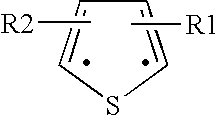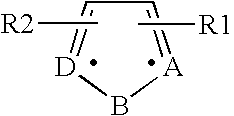Pharmacological agents and methods of treatment that inactivate pathogenic prokaryotic and eukaryotic cells and viruses by attacking highly conserved domains in structural metalloprotein and metalloenzyme targets
a technology of pathogenic prokaryotic and eukaryotic cells and viruses, applied in the direction of biocide, heterocyclic compound active ingredients, organic chemistry, etc., can solve the complex role of metal ions in neurodegenerative diseases
- Summary
- Abstract
- Description
- Claims
- Application Information
AI Technical Summary
Benefits of technology
Problems solved by technology
Method used
Image
Examples
example 8
Treatment of Chickenpox
Treatment of chickenpox can be accomplished by topical treatment with furoic acid or 2-TH acid when the rash is in the early stages. A 5% to 10% solution of the antiviral compound can be applied to the lesions of a patient with chickenpox. Since herpes virus replication will be inhibited, it is expected that the lesions will not erupt into blisters and that the treated areas will not itch.
example 9
Treatment of Smallpox and Biological Warfare
The poxviruses are a family of large, enveloped DNA viruses. The most notorious poxvirus is variola, the causative agent of smallpox. Smallpox was important because of the morbidity and mortality cause by this virus. Despite the eradication of naturally occurring smallpox and the availability of a vaccine, the potential for weaponization of variola virus continues to present a universal threat. The aerosol infectivity of the virus, the ease of large-scale production, and a naive human population remarks the importance of smallpox virus as a weapon. Vaccinia vaccination remains the preeminent countermeasure for smallpox but its application and development of immunity is slow and thus it is not appropriate to counteract bioterrorism in all its forms. The drug N-methylisatin-p-thiosemicarbazone (Methisazone) possess some efficacy in post-exposure prophylaxis but is shows significant toxicity. An opportunity exist to correct and counteract thi...
example 7
Inflammation and Inhibition of Leukotriene A.sub.4 Hydrolase by 2-TH Acid and Analogues: High Specificity is Achieved by Substituting the Position 3.degree. F. 2-TH Acid with a Hydrophobic Chain That Interacts with the Hydrophobic Pocket of the Target Enzyme
The chelating agents of the present invention can also be used to inhibit specific enzymes involved in inflammation such as Leukotriene A.sub.4 hydrolase (LA.sub.4 H)in various disease conditions (FIG. 14). This enzyme is a zinc-dependent metalloproteinase. LTA.sub.4 hydrolase belongs to the M1 family of metallopeptidases. It is of practical medical interest to inhibit an enzyme that is involved in inflammatory diseases. The administration of the specific chelating agents of the instant invention can prevent unwanted inflammatory responses mediated by this enzyme. The chelating agent can be administered orally or parenterally in doses described elsewhere in this application.
Based on the zinc signature, sequence homology and amino...
PUM
| Property | Measurement | Unit |
|---|---|---|
| dissociation constant | aaaaa | aaaaa |
| pH | aaaaa | aaaaa |
| RI | aaaaa | aaaaa |
Abstract
Description
Claims
Application Information
 Login to View More
Login to View More - R&D
- Intellectual Property
- Life Sciences
- Materials
- Tech Scout
- Unparalleled Data Quality
- Higher Quality Content
- 60% Fewer Hallucinations
Browse by: Latest US Patents, China's latest patents, Technical Efficacy Thesaurus, Application Domain, Technology Topic, Popular Technical Reports.
© 2025 PatSnap. All rights reserved.Legal|Privacy policy|Modern Slavery Act Transparency Statement|Sitemap|About US| Contact US: help@patsnap.com



